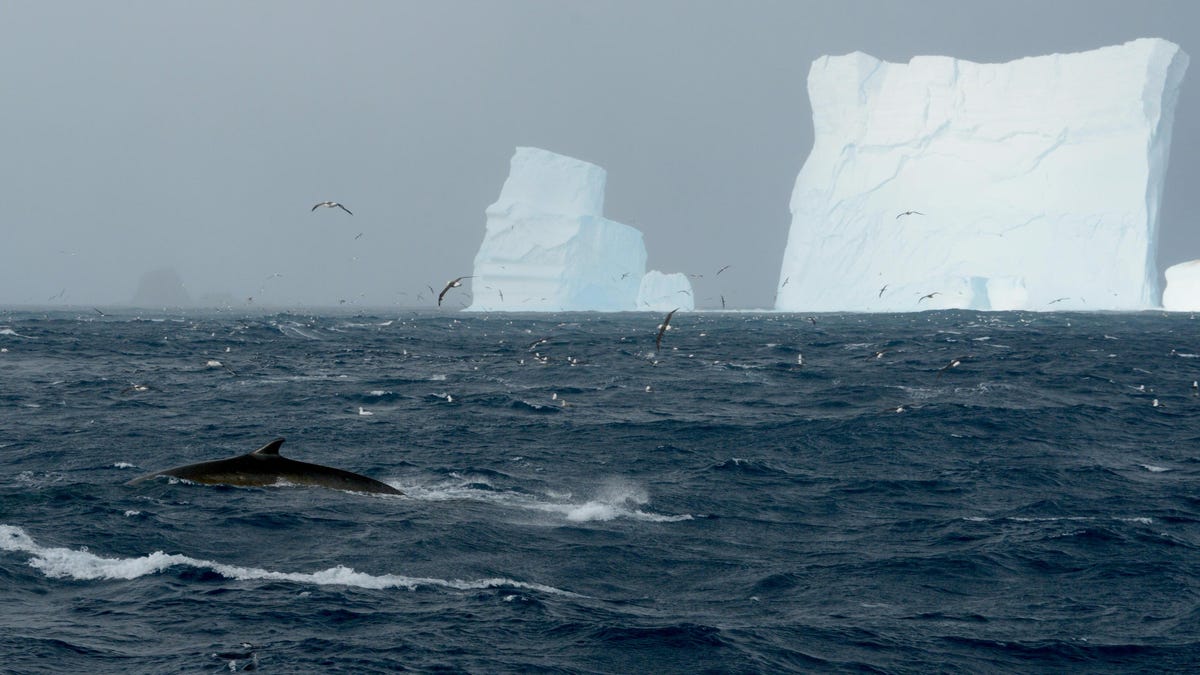Antarctica's Fin Whale Population Is Rebounding. Here's Why That's a Big Deal
Populations of the second-biggest whale on Earth are rebounding in the icy south.

A fin whale cuts through the water off Elephant Island in 2019.
During the heights of industrial whaling in the early 20th century, fin whales seemed doomed. The statistics are grim: More than 700,000 fin whales were killed between 1904 and 1976, the year a catch quota of "zero" was instated. Even though the killing slowed (whaling nations such as Japan still caught fins for "research purposes"), surveys taken after 1978 showed the slaughter had driven the whales from their feeding grounds in the Antarctic -- essentially, the fin whale disappeared.
That, of course, was bad news. But the good news is a new round of survey data, collected during two expeditions in 2018 and 2019, shows populations are recovering, returning to their ancestral feeding grounds. The new research, published in the journal Scientific Reports on Thursday, also recorded aggregations of up to 150 individual whales feeding just off the coast of Antarctica -- a phenomenon not captured on video before.
"I'd never seen so many whales in one place before and was absolutely fascinated watching these massive groups feed," said Bettina Meyer, a biologist at the Alfred Wegener Institute for Polar and Marine Research and author on the study.
Fin whales feeding off the coast of Elephant Island, Antarctica
Fin whales are the second largest species of whale on Earth, right behind the mammoth blue whale. Adults can grow up to 90 feet long, a little bigger than two school buses.
The research team went south on the German icebreaker Polarstern in 2018 and the Pelagic Australis in 2019. From the vessels, they conducted surveys from the deck and by air, taking 22 helicopter flights around the Antarctic Peninsula. The team often spotted smaller groups of whales, between one and four individuals. But off the coast of Elephant Island, in the Weddell Sea, they hit a rich vein of whale gold.
Their surveys identified huge groups of whales feeding on krill, one of the region's most important species, with two observations estimating about 150 individual whales all going to town on a swarm of krill. This, they note, is the largest aggregation of baleen whales in the literature (and features in David Attenborough's "Seven Worlds, One Planet" documentary). The feeding frenzy lasts only a few minutes before the whales disperse again.
Using the observations, the team was able to estimate the amount of fin whales in the region, but they note these numbers aren't perfect — there's a lot of unknowns when it comes to whale numbers because it's hard to access this part of the world and adequately document them, year after year.
"Even if we still don't know the total number of fin whales in the Antarctic, due to the lack of simultaneous observations, this could be a good sign that, nearly 50 years after the ban on commercial whaling, the fin whale population in the Antarctic is rebounding," said Meyer.
The return of the whales to the ancestral feeding grounds is absolutely a feel-good story about the whales and it's one that highlights the benefit of the whaling moratorium that came into effect in 1985. However, their return also has flow-on effects for the local environment. Whales are particularly useful at cycling nutrients through the food chain. They gobble down krill and then poop out iron-rich feces, in turn giving the krill something to feed on.
The researchers reason this could increase "productivity" of the Southern Ocean. Krill are eaten, feces are excreted, algae (phytoplankton) populations boom, krill populations boom, whale populations boom... it's a cycle. And phytoplankton captures carbon dioxide from the atmosphere. The big whales like the fin act as "carbon sinks" because they hoover up all the carbon in phytoplankton (and the krill that feeds on it) and store it in their bodies. When the whales die, they sink, taking their carbon with them to the bottom of the ocean.
When we hunted them to near extinction, we were unwittingly disturbing the carbon cycle in the Southern Ocean; we were pulling another lever that accelerates climate change. Whale populations rebounding won't just benefit the Southern Ocean ecosystem -- it actively benefits a world running headfirst into the climate crisis.

